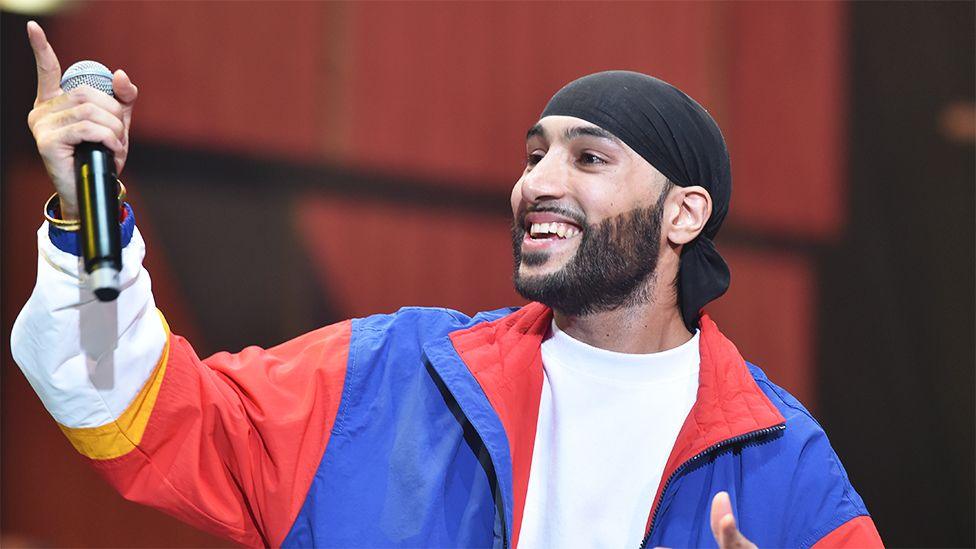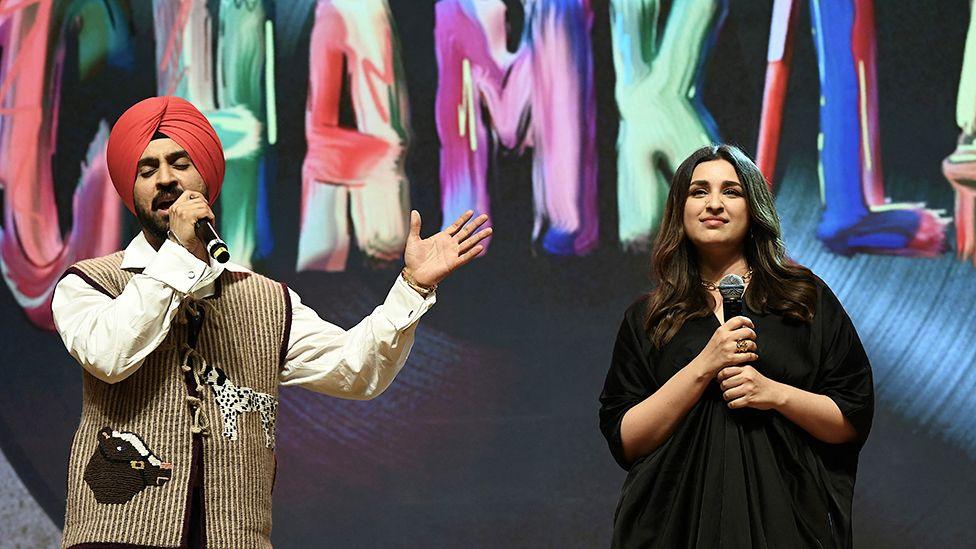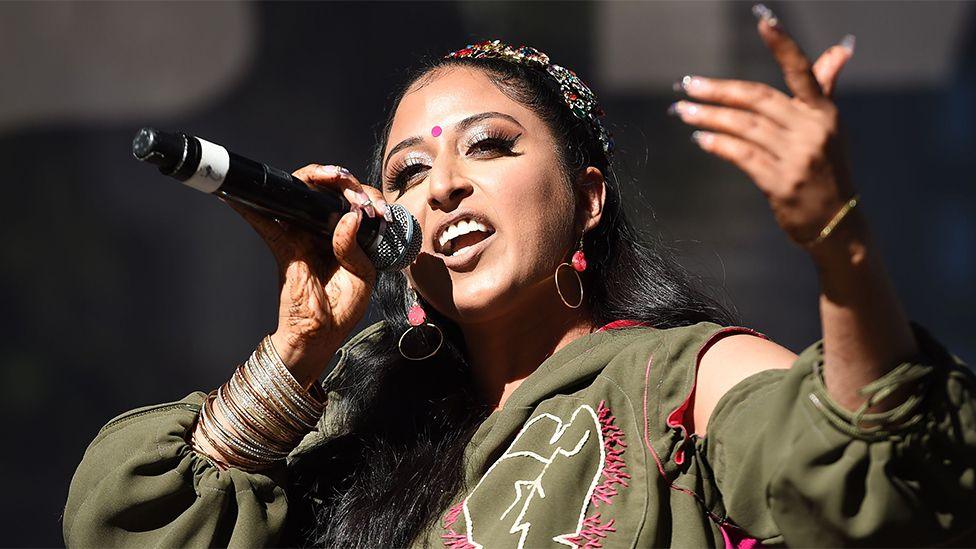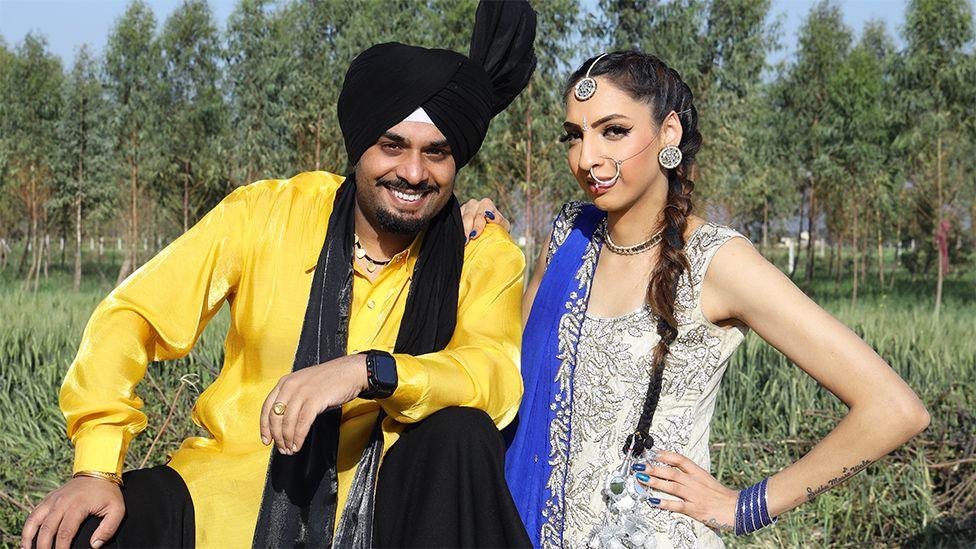How old-school bhangra is influencing South Asian music today

Manni Sandhu feels the Punjabi "duet phase" is coming back
- Published
When you think of bhangra music, high-energy, rhythmic and heavy beats probably come to mind.
But it hasn't always been this way - the genre's been around a while and has its roots in traditional folk music.
Back then male and female duets, and sounds of the harmonium, accordion and guitar were the key features of its signature style.
Since the 1970s and 1980s - considered a golden age - bhangra has been adapted and fused with modern urban melodies.
As the genre moved forward the duets that helped to shape it seemed to go out of fashion.
But they could be making a comeback.
British Asian record producer Manni Sandhu is the man behind recent number one single Forever.
The track, featuring a duet between singers Tegi Pannu and Prem Lata, was top of the Official British Asian Chart for five weeks in a row.
It was also streamed more than 30 million times across Spotify and YouTube combined, and peaked at number two in the global Asian music chart.
"The duet phase is definitely coming back," Manni tells BBC Asian Network.
'It's gone totally berserk'
Manni feels Forever's popularity is down to an increased appetite for the type of Punjabi folk music which was popular decades ago.
"Our industry definitely went through a phase where we were trying to imitate and be more like the Western side," he says.
"But it was never going to make it that way because that's not authentic.
"I feel like the music coming out recently in the last six or seven months has definitely got a much more traditional sound to it."
Manni says Forever's beats are still "a little bit urban", but the vocals and lyrics have an "authentic old-school kind of folk Punjabi feel".
"I'm glad the music is more of a folk sound because that's what it should be," he adds.

Diljit Dosanjh and Parineeti Chopra starred in a Netflix biopic on 1980s Punjabi artist Amar Singh Chamkila
That original folk sound was heavily influenced by Amar Singh Chamkila, described as the "Elvis of Punjab" in the 1980s.
His story was captured in Netflix biopic Chamkila, starring Diljit Dosanjh - arguably the biggest Punjabi artist in the world right now.
Many of Amar Singh Chamkila’s hits were duets with Amarjot, played by Bollywood star Parineeti Chopra in the film.
A month after the film's release, rapper and songwriter Raja Kumari released In Love, a traditional duet-style song with Guru Randhawa.
The music video was shot in Punjab and has over 37 million views on YouTube.
"We're all going back to seeing the classics and understanding what was so special about that," she tells BBC Asian Network.

Raja Kumari wants to do more duets
Indian-American Raja has previously collaborated with artists including Iggy Azalea, Fifth Harmony, Sidhu Moose Wala and Fall Out Boy, but says "everyone is always trying to get back to the roots".
"The amount of love that I've received from the Punjabi community for this song. It just encourages me to keep trying doing more," she says.
And she feels it’s important to preserve the original sounds for a younger audience.
"I hope that when people do see these modern duets, it makes them go back and understand where it comes from."
This resurgence isn’t limited to mainstream music.
Since the release of the Netflix film, a Chamkila and Amarjot tribute act say they've received an increasing number of bookings around the world.

Sadi Jori - a Chamkila tribute act - say their genre's popularity is rising
Banger and Sammy, whose group is called Sadi Jori, say the rise in popularity was noticeable when they performed in India.
"It got to a point where you couldn't see anything because there were so many people," Sammy says.
"It took us two minutes to get from our car to the stage. But to get from the stage back to our car, it took us two hours.
"It's not a fashion. I think it's always been there, but now it's coming to the forefront and people are proud of it."
Banger says they’ve been getting bookings in places where Chamkila originally performed, as well as Dubai, Bulgaria, Australia and Italy.
"Punjabi music duet singing is definitely back, it's gone through the roof.
"It's always been there for me, but recently, it's just erupted and gone totally berserk," Banger says.
The night South Asians took over Glastonbury
- Published28 June 2024
Glastonbury announces dedicated South Asian space
- Published19 April 2024
British Asian artists hope for chart show boost
- Published18 April 2024
According to Rupinder Virdee from the PRS for Music group, like any genre, there are "peaks and troughs" but the "super fans at the core of the scene have remained a constant".
She feels the recent greater interest can be attributed to a few factors, one of those being more worldwide attention for Punjabi music generally.
"We are seeing inclusion on wider platforms for the live sector such as Glastonbury, Coachella, recently Latitude and Lolapalooza including Punjabi artists into those stages."
She adds there has also been "music growth in India" in terms of streaming and publishing, which is helping to spread the sound of the genre globally considering the country's position as a rising economic power.
"The penetration of production, beats and language is a non-negotiable, and we have a clear sense of pride for Punjabi music culture that is being lauded.
"More people are open to the sounds regardless of language barriers," she says.
And Rupinder predicts the growth will continue "in the same way that Afrobeats grows", but it's dependent on continuing to provide the right tools.
"We need a strong talent pipeline, investment, strategy and advocacy from our executives to build supportive infrastructure and global connectivity to see this."
